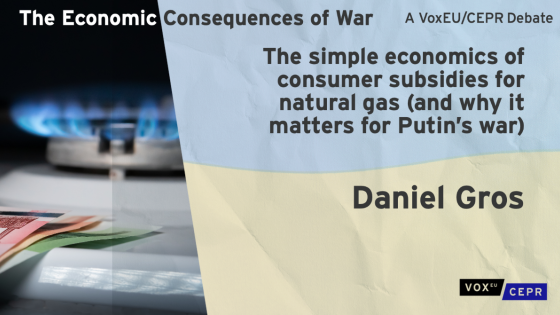Energy subsidies in developed and in developing countries
The adverse economic and environmental consequences of energy subsidies are widely recognised (Clements and others 2013a 2014, International Energy Agency 2014, OECD 2009, World Bank 2010). For instance, as recently reported by Clements et al. (2013b), IMF estimates found that in 2011, post-tax energy subsidies – which arise when energy taxes are not high enough to capture the negative externalities associated with energy consumption – were a whopping $2.0 trillion, the equivalent of over 2.9% of world GDP. These subsidies crowd-out higher priority public spending (e.g., on education, health, and public infrastructure), benefit mostly higher-income groups, and cause substantial local and global environmental damage.
While energy subsidies are a problem in both advanced and developing countries, the underlying cause in developing countries is somewhat different. In many developing countries, domestic consumer prices are directly controlled by governments and only adjusted on an ad hoc basis, typically in response to mounting fiscal pressures. While such price controls reduce the volatility of domestic energy prices, this volatility is simply transmitted to the budget, disrupting budget planning and execution, and crowding out more productive public spending.
Rising international prices and energy subsidies
In times of rising international oil prices, energy subsidies often quickly escalate and become a major fiscal headache. When international prices increase, there is a temptation to perceive these as temporary and therefore not to pass them onto domestic consumers. But if international prices are sustained, then the domestic price increases required to eliminate subsidies quickly become more politically challenging resulting in policy inertia and escalating subsidies. The large domestic price increases that are eventually required when faced with fiscal realities serve only to further politicise the setting of domestic energy prices. So, the fiscal cost of subsidies is but a symptom of an underlying policy problem, namely, direct government involvement in the pricing of energy. While the recent decline in international energy prices has meant that the symptoms have abated (i.e., lower energy subsidies), the underlying policy problem looms as large as ever.
We have, of course, been here before – and not so long ago either. After the mid-2000s, international oil prices started to increase steadily before increasing more sharply over 2007 and the first half of 2008 (Figure 1). Across all developing regions, many countries failed to pass these increases onto domestic consumers. For instance, more than half of developing countries passed on less than two-thirds of the increase in international diesel prices to domestic consumers over this period. This led to a substantial increase in diesel subsidies in many countries. The resulting fiscal cost was very substantial, with the combined cost for diesel, gasoline, and kerosene exceeding 3% of GDP on an annualised basis in over half of developing countries (Figure 2). The total fiscal cost would be even higher if subsidies to other energy products, such as LPG and electricity, were included.
Figure 1. International oil prices and domestic pass-through, 2000-2014 (indexed at January 2000=100)

Source: IMF World Economic Outlook; US Energy Information Administration.
Note: Pass through is defined as the increase in domestic prices divided by the increase in international prices in US dollars.
Figure 2. Fiscal implications of changing fuel taxes, 2004-2012

Source: IMF Staff Estimates; International Energy Agency; US Energy Information Agency; Deutsche Gesellschaft für Internationale Zusammenarbeit (GIZ).
Note: Fiscal cost refers to the increase in fuel subsidies or decrease in tax revenues for gasoline, diesel, and kerosene, based on changes in end period prices and annualised cost. Numbers in brackets refer to the size of the sample of countries in each group.
Decline in international oil prices
The collapse of international oil prices in the second half of 2008 came like manna from heaven. Fuel tax levels increased and subsidies decreased as these price decreases were not passed on to domestic prices. However, the relief was short-lived as international oil prices rebounded sharply from early 2009—by April 2011 international prices had almost reached the peak levels seen in mid-2008. Again, taxes fell and subsidies increased over the next few years and the fiscal costs associated with controlled prices escalated, wiping out much of the fiscal gain over the second half of 2008.
The recent decline in international prices has presented countries with another opportunity to adopt a permanent solution to the burden of energy subsidies. However, as highlighted in a recent IMF book (Clements et al. 2013a), transforming this temporary respite into a permanent solution will require advance planning and foresight on the part of policymakers. And there may be a case for some cautious optimism. The Indian government, having already liberalised gasoline prices in 2010, has recently announced that diesel prices will now be deregulated. This follows a long period of small increases in domestic diesel prices, which were increased by half a rupee per month since January 2013. But only time will tell whether this deregulation will prove permanent and survive any future sharp increase in international prices. But, while countries such as Egypt, Indonesia, and Iran have recently implemented large energy price increases to substantially decrease subsidies, they have yet to address the core problem of direct government price fixing.
Even after removing current subsidies, many countries will be reluctant to make the big jump to complete price deregulation. For such countries, an attractive interim solution may be to adopt an automatic pricing mechanism with some domestic price smoothing formally built into the mechanism. A number of countries (including Chile, Peru, and Mauritius, as well as a number of countries in sub-Saharan Africa) already have adopted such mechanisms. This approach essentially shares international price volatility between domestic consumers and the budget. By allowing both price increases and decreases, but capping these changes, it ensures full pass through of international price movements to domestic consumers over the medium term while protecting domestic consumers from sudden sharp increases and avoiding an escalating subsidy bill. Also, by demonstrating a government’s willingness to avoid subsidies, and the disruption of markets and tensions between suppliers and government that is often associated with these, it can renew private sector confidence and investment and pave the way for a more permanent solution through complete price deregulation.
Figure 3 shows how a simple price-capping smoothing mechanism would have worked over the past decade. If monthly price increases were limited to 3-5% of existing prices, then domestic prices would have initially increased along with international prices over 2004 and 2007, but avoiding the volatilities observed in international prices. Subsequently, domestic price increases would have lagged behind the sharp international price increases up to the middle of 2008 when international prices peaked. While international diesel prices peaked at over $1.00 per litre, the maximum domestic price would have been in the range $0.8-$0.9 per litre under the smoothing mechanisms. However, continued smoothing over the downward path of international prices would have meant that domestic prices decreases would have been slower and less pronounced than international price decreases over the second half of 2008. Subsequently, domestic price increases would have more or less mimicked changes in international prices, but again avoiding the sharp increases in international prices over the second half of 2010.
Figure 3. Domestic diesel prices under price smoothing bands, 2004-2014

Source: Coady and other 2012; IMF World Economic Outlook; US Energy Information Administration.
So it is time to be opportunistic! Such opportunities for much needed reform do not occur very often. Indeed, if international prices continue their downward trend over the coming months, then quick adoption of such mechanisms may even be associated with initial decrease in domestic prices in many countries, which can only help to strengthen public support for the mechanism. Greater social dialogue and transparency, including through publishing the details of the mechanism online and in national news outlets, can also reinforce such support as can strengthening safety nets to protect the poorest.
Disclaimer: The views expressed herein are those of the authors, and should not be attributed to the IMF, its Executive Board, or its management.
References
Clements, B, and others (2013a), Energy Subsidy Reform: Lessons and Implications, (Washington DC: International Monetary Fund).
Clements B, Fabrizio S and I Parry (2013b), “Now more than ever: Reforming energy subsidies throughout the world”, VoxEU.org, 27 April
Clements, B, and others (2014), “Energy Subsidies: How Large Are They and How Can They Be Reformed?”, Economics of Energy & Environmental Policy, 3 (1).
Coady, D, and others (2012), “Automatic Fuel Pricing Mechanisms with Price Smoothing: Design, Implementation, and Fiscal Implications”, Technical Note and Manual, Fiscal Affairs Department, International Monetary Fund.
International Energy Agency (2014), “Developments in Fossil-Fuel Subsidies", Chapter 9, World Energy Outlook 2014, Paris.
Organisation for Economic Co-operation and Development (2009), “The Economics of Climate Change Mitigation: Policies and Options for Global Action beyond 2012”, Paris.
World Bank (2010), “Subsidies in the Energy Sector: An Overview”, Background Paper for the World Bank Group Energy Sector Strategy, Washington.





